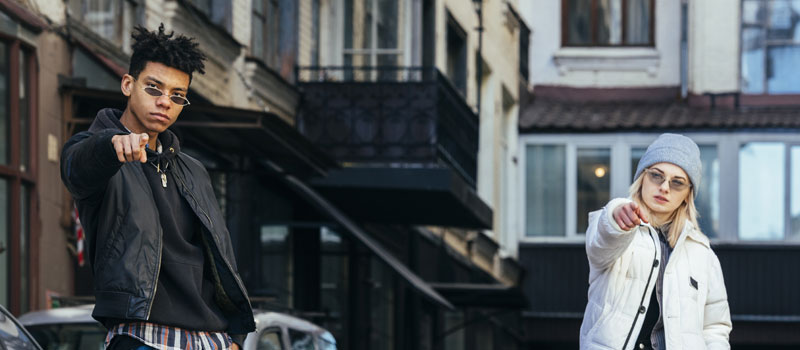
In the revolving door of fashion’s cyclical machine, trends are often reincarnated, drawing inspiration from past moments while infusing them with more contemporary nuances. One such resurfaced trend currently catching fire in pop culture and in elite fashion circles is the ‘Mob Wife’ aesthetic, which finally silenced ‘quiet luxury’, the trend on everyone’s fashion mood board throughout most of 2023.
While many articles about the trend have cited onscreen moments such as Sharon Stone’s character from the movie “Casino” and the characters on the reality show, wait for it– “Mob Wives” – as an influence on the Mob Wife aesthetic, a few prominent Black female performers from the not-too-distant past would like to have a word.
Marked by in-your-face opulence, fur coats, body-con silhouettes, and flashy accessories, this style channels the glamour and allure of 90’s luxe hip-hop, epitomized by performers like Mary J. Blige and Foxy Brown.
But is the Mob Wife trend a mere homage to the past, or does it represent a genuine evolution of the 90’s hip-hop style for our present moment? Let’s unravel the layers of this trend, examining its defining elements and cultural relevance, and comparing it to contemporary examples.
At its core, the Mob Wife trend exudes an unapologetic aura of luxury and empowerment for women: think oversized sunglasses, decadent fur coats draped over shoulders, and precision-cut form-fitting dresses. These elements point back to the heyday of 90s hip-hop culture, where fashion was more than just clothes– fashion was a way to make a statement about self-assurance and defiance against societal norms.
Often hailed as the “Queen of Hip-Hop Soul” Mary J. Blige exemplified this ethos, seamlessly melding streetwear with haute couture to create a signature style that radiated confidence and authenticity. Her penchant for fur coats, combined with luxury labels, became synonymous with a specific type of urban elegance that transcended boundaries.
Blige favored bold and form-fitting looks, as was often seen in figure-hugging dresses or sleek suits with plunging necklines and high hemlines, reminiscent of the glamorous yet assertive demeanor associated with women associated with members of the Mob.
Foxy Brown, with her provocative lyrics and audacious fashion choices, similarly embodied the epitome of feminine strength and sensuality, captivating audiences with her unapologetic demeanor.
Both Mary J. Blige and Foxy Brown had a style that was grounded in iconic brands and labels that were emblematic of the fashion landscape of the mid-to-late 90s. From designer names like Versace, Moschino, and Gucci to streetwear staples like Timberland boots and oversized gold jewelry, both performers were masters at seamlessly blending high-end luxury with urban sensibilities that connected them with their fans.
Their penchant for fur, leather, and bold accessories further cemented their association with the Mob Wife aesthetic, capturing a fusion of streetwise grit and upscale elegance that remains influential in contemporary fashion. Their embrace of bold, fearless style paved the way for the current Mob Wife trend.
Fast forward to the present, and a new iteration of the Mob Wife trend continues to blend elements of opulence, power, and streetwise glamour, but with a modern twist that reflects the current evolving fashion landscape. Today, luxury brands such as Balmain and Off-White have been synonymous with the aesthetic, offering edgy yet sophisticated pieces that resonate with those seeking to embody the aura of contemporary Mob Wife chic.
Balmain, under the creative direction of Olivier Rousteing, has become a staple in the wardrobes of individuals embracing the mob Wife trend. Known for its sharp tailoring, bold embellishments, and strong silhouettes, Balmain collections exude confidence and authority, aligning perfectly with the fierce femininity associated with the trend.
Off-White, founded by the late Virgil Abloh, merges luxury fashion with streetwear sensibilities, offering a fresh take on the Mob Wife trend with its eclectic mix of high-end pieces and urban-inspired designs.
Influential figures in pop culture and social media have played a significant role in popularizing the new version of the Mob Wife trend. Celebs like Kim Kardashian, Cardi B, and Jennifer Lopez have been spotted wearing brands and labels that are synonymous with the aesthetic, often showcasing their own interpretations of the style.
Social media influencers and tastemakers have also contributed to the trend’s resurgence, sharing their take on Mob Wife-inspired looks with their followers and further cementing its status as a fashion trend that anyone can adopt, on some level.
However, while the parallels between the Mob Wife trend and 90s hip-hop fashion are evident, some differences set them apart. The resurgence of this aesthetic coincides with a broader cultural shift towards nostalgia, as Millennials and Gen Z yearn for the aesthetics of the past as a way to experiment.
The Mob Wife trend also symbolizes a departure from traditional gender norms with women reclaiming symbols of power and authority that were once dominated by men. In the 90s, hip-hop fashion was often accompanied by masculine imagery, yet today, women are at the forefront, shaping and defining these trends on their terms.
This trend is a modern interpretation driven by nostalgia, inclusivity, and empowerment. By fusing elements of the past with contemporary sensibilities, it goes beyond just imitation. It offers younger generations a fresh perspective on a timeless style that should center the pioneering Black women who paved the way for its resurgence.